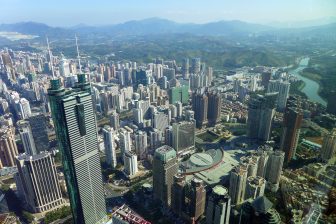
How air pollution, green space and the ‘built environment’ may shape a child’s body mass index
Exposure to higher air pollution levels and greater population density during the early months of life may be associated with an increase in children’s body mass index (BMI).
The claim is made in a new study of almost 80,000 children living in urban areas of Spain’s Catalonia region which, for the first time, analysed the relationship between urban exposures and BMI growth trajectories.
In contrast, living in areas with greater exposure to green space and a more favourable land use mix (a measure of the variety of building types and services in an area) could be associated with the opposite effect, according to the Barcelona Institute for Global Health (ISGlobal).
These effects may begin at an early stage
ISGlobal says there is a growing body of evidence that environmental urban exposures, such as air pollution, green space and the built environment, may be linked to effects on growth and obesity in children. These effects may begin at a very early stage, during pregnancy and the first few years of life.
Jeroen de Bont, researcher at ISGlobal and the IDIAPJGol Foundation, said: “Urban environments are characterised by multiple exposures that may influence the BMI, but the results of research to date have been inconsistent and earlier studies did not assess simultaneous exposures.”
The most telling aspect of this new study was that multiple exposures were evaluated simultaneously. The data analysed was extracted from a database of primary care medical records in Catalonia, which included 79,992 children born between 2011 and 2012 in urban areas, who were followed up until they reached five years of age. BMI growth curves were calculated based on routine measurements of weight and height.
‘..A more favourable land use mix’
At the same time, the authors estimated various urban exposures at the level of the census tracts where the children live. These included air pollution (nitrogen dioxides [NO2] and particulate matter [PM10 and PM2.5], green spaces and several characteristics of the built environment (population density, street connectivity, land use, and walkability).
“Our results suggest that the population density in urban areas and exposure to higher levels of air pollution may be associated with a small increase in BMI in children up to five years of age and that greater exposure to green spaces and a more favourable land use mix may be associated with a small decrease in BMI,” added de Bont. “The fact that these associations were strongest during the first two months of life…could be explained by the effects of exposure during pregnancy, which would persist over time”.

Study coordinator and fellow researcher at ISGlobal, Martine Vrijheid, said earlier findings indicated that the relationship between BMI and air pollution might be explained by the fact that the pollution ‘could affect foetal growth through various factors, such as oxidative stress and inflammation, and lead to alterations in the basal metabolism of infants, thereby increasing the risk of obesity by inducing insulin resistance and hormonal alterations’.
Early years of life are a time of great sensitivity
“On the other hand, the possible relationship between a lower BMI and exposure to green space could be explained by the fact that such spaces are a valuable resource favouring physical activity on the part of both mother and child and result in a beneficial effect on the development of the foetus and later on that of the child,” she added. “A different hypothesis is that the association could be explained by another possible mediating factor – the lower levels of air pollution observed in the greener areas in the study.”
While there is no clear consensus on how the land use mix affects BMI, ISGlobal concluded that a more varied land use mix decreases the distance between housing, work and services and therefore favours walking and cycling, which in turn increases levels of physical activity.
Vrijheid added: “For children, the early years of life are a time of great sensitivity; they represent a window of special vulnerability to environmental exposures that can permanently affect the structure, physiology and metabolism of the child’s body. Future studies should take into account multiple exposures in the urban setting instead of analysing exposure one by one, as encouraged by the exposome concept, which studies many different exposures a person faces altogether.”
The study was funded by the La Marató de TV3 Foundation and published in the journal Environmental Pollution.




